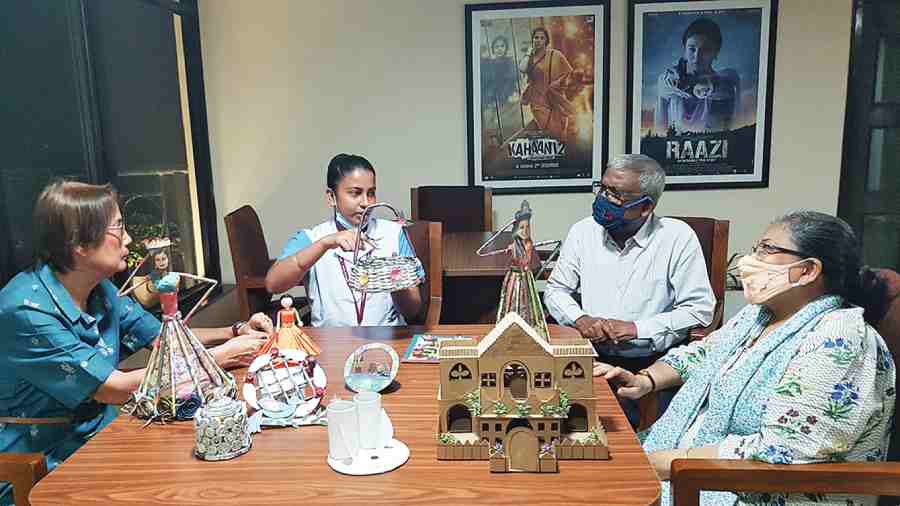Kabita Dolai
Day job: Attendant at Snehodiya senior
citizens’ home, New Town
Kabita Dolai is an attendant at Snehodiya but she does much more than just take care of the residents’ medical needs. The gifted girl presents them with houses, dolls and baskets that she makes out of recycled materials, spreading smiles and earning blessings from them all.
“I never knew I had this talent and started making crafts only during the pandemic,” says Kabita, who joined the senior citizens’ home in 2019. Now she sits in their common area and toils away till a bell from a resident’s room calls her away.
She has made jewellery boxes, cycles, flower vases, fruit baskets out of old newspaper…. She does turn to YouTube for tips but mostly makes these without help.
“I forage old newspapers for colourful pages and use up the cardboard boxes that come as packing for residents’ online purchases,” says Kabita. “I also take help from residents. For my doll’s belt I recycled the rakhi Kumkum Nandy had tied on another resident Bikash Sen’s wrist. New residents to the home are presented welcome kit that includes artificial plants. I have recycled those to embellish the garden on my cardboard house too.”
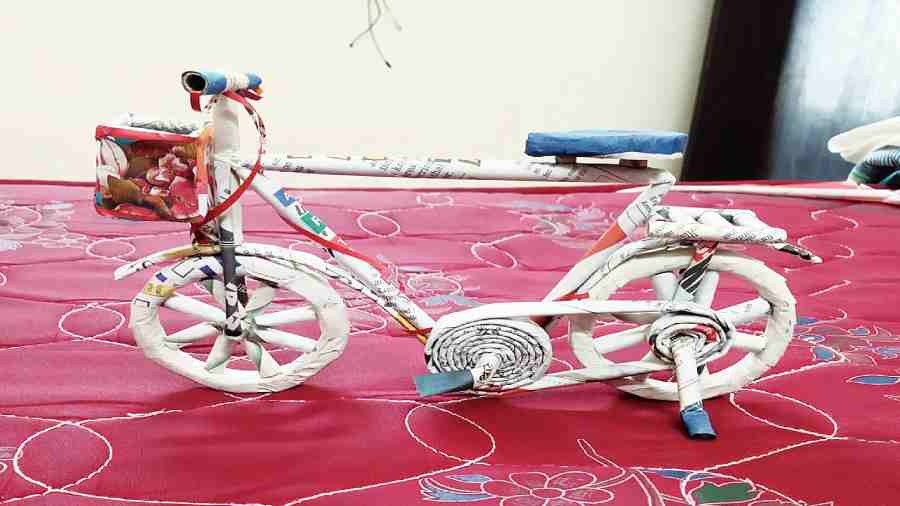
Brinda Sarkar
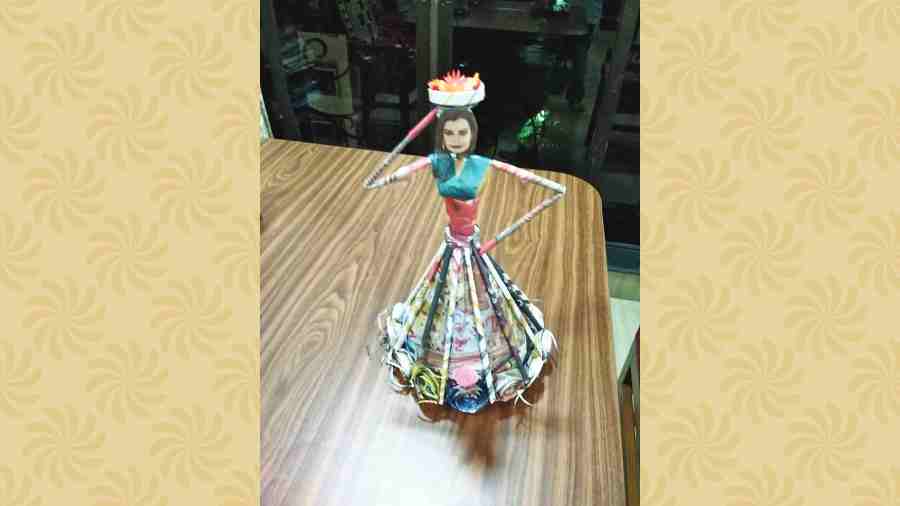
Brinda Sarkar
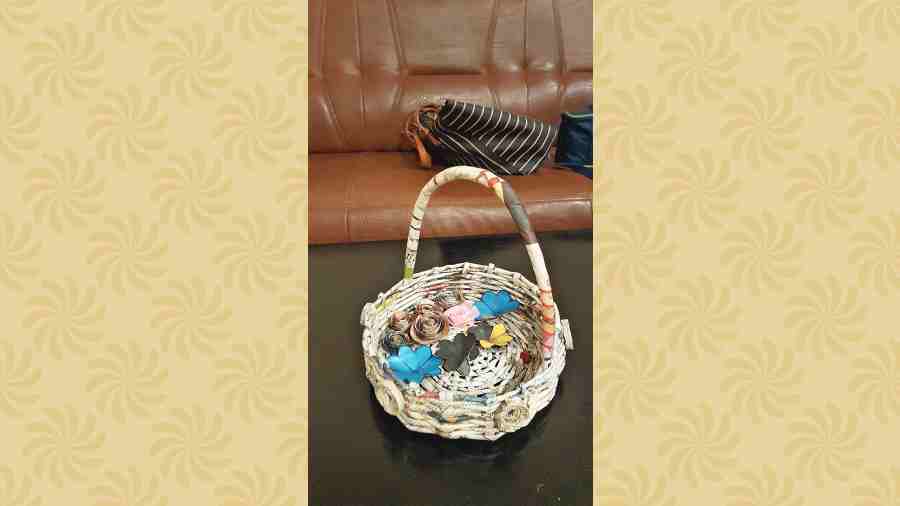
Brinda Sarkar
The West Midnapore girl had not had much scope for learning craft in school and was in fact a kabadi player. The items she’s making now are largely from her own imagination and the execution is through trial and error. She uses just a ruler, glue, blade and a pair of scissors for it.
Residents encourage and appreciate her work. Amita Das keeps aside any ribbons she chances upon to give Kabita and Nandy has gifted her glue to work with. “I am an origami artiste myself and can judge the worth of her work,” she says. “It is excellent and she sits for hours at it with dedication. I’ve tried teaching Kabita some origami too but she doesn’t have time.”
She mentions several “dadus and didus” who encourage her — Tapan Bhattacharya, Krishna Ghosh, Sucheta Ghosh as well as the officials who work at Snehodiya. They have graciously kept some of her items at Snehodiya’s lobby and office too.
Residents are now asking Kabita to showcase her skills on YouTube, exhibitions or sell them at fairs. She hasn’t thought about it much. “As of now, I just want to gift them to those who can value them,” she smiles.
Brinda Sarkar
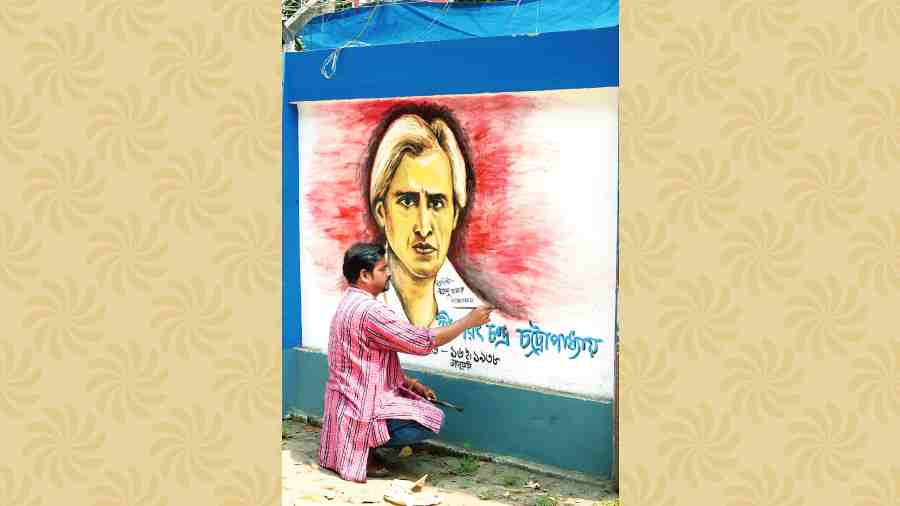
ukhendu Khamaru colours his sketch of Saratchandra Chattopadhyay outside Baisakhi. Debasmita Bhattacharjee
Sukhendu Khamaru
Baisakhi Abasan
Day job: Upper division clerk at Nirman Bhavan
A resident of Baisakhi Abasan has taken it upon himself to illustrate the boundary wall of the housing complex. Sukhendu Khamaru, a government employee who is also an artist, has been on the job since December and has so far completed 36 portraits of illustrious names from Bengal and beyond.
His ongoing work is there for everyone taking First Avenue to see as he has started with the front wall.
“The young generation needs to be more aware of Bengal’s icons. So I thought of beautifying our wall with their portraits,” says Khamaru, a fine arts graduate who had earlier supervised the sculpting of a dead tree to create an installation at the Central Park fairground.
The 45-year-old upper division clerk of the urban development department had started out funding his wall art venture from his own pocket but once his senior colleagues came to know and visited the spot, they were impressed by the quality of the work and encouraged him to extend his scope to the entire boundary wall. “They are funding the cost of the colours now,” he said.
Khamaru can be seen at work in the evenings. “With the rise in mercury, I cannot carry on at daytime. Still I manage to complete one portrait every night, from the sketch to the colouring,” he says.
For the side walls, he plans to include international figures. Some will carry representations of their work too. Leonardo Da Vinci’s portrait, for instance, will be accompanied by replicas of his best-known creations, The Last Supper and Monalisa. Many of the illustrations carry a quotation of the person.
He has plans to draw some cartoon figures too to attract children. And in between portraits, there will be natural sceneries to break the monotony of faces.
The only spoilers could be defacement by random posters and political graffiti. In fact, before the elections he had to fend off a party worker. “The complete illustrations are not under threat. They target the whitewashed sections of the wall before I can lay hands on them.”
The total project would require about 700 illustrations. “I hope to finish by the Puja,” he smiles.
Sudeshna Banerjee
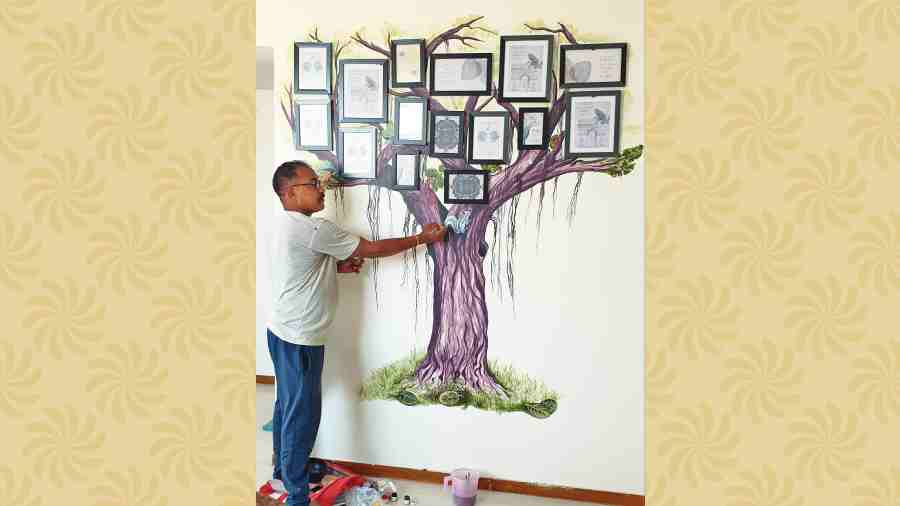
Raghunath Behera paints a wall at a Uniworld City resident’s home
Raghunath Behera
Behind Uniworld City
Day job: Plumber
A plumber at Uniworld City used to have his paintings on sale at art galleries in the national capital. His works would sell for tens of thousands of rupees. He was a respected painter, sculptor and art teacher. And then the pandemic happened.
“Well, Covid was the straw that broke the camel’s back,” says Raghunath Behera. “The art industry took a hit since cheap Chinese prints started flooding the market some 15 years ago. What a painter would hand-make and sell for Rs 5,000 their machines would sell at 100. Buyers wouldn’t know the difference.”
Behera was born in Odisha. Always fond of art, he pursued a diploma in the subject after school and took up his first job of painting film posters. “It was for a film called Kshatriya starring Vinod Khanna, Sanjay Dutt and Sunny Deol,” smiles the man who still watches the film on his phone once in a while for the sake of nostalgia.
Soon afterwards, he moved to Delhi in 1995 and started painting for exhibitions. “My favourite topic was love — be it between a mother and child or birds. But it was an imaginary painting of the surroundings of Puri’s Jagananth temple 200 years ago that sold for the highest sum— Rs 30,000,” says the artiste who would also take orders for replicas of M.F. Hussains, Satish Gujrals and Sudhanshu Sutars, with whom he has worked on a series of paintings of Gandhi.

One of Behera’s paintings
When the Chinese replicas reduced business, Behera realised he had to take up another trade. “I was already teaching art to children but I had a wife and two kids and it wasn’t enough to make ends meet. It broke my heart. Some of my friends were plumbers and said this was a steady stream of business. They taught me the work and I started fixing bathrooms. It helped that I had a knack for fixing things like mobile phones and fans,” he says.
After the lockdown, things went from bad to worse. Behera shifted to Calcutta as it is closer to Odisha than Delhi and he can visit home more often. He has found a home behind Uniworld City and caters to the residents of the complex. “Every house that I visit to fix a toilet, I show pictures of my paintings on my phone in the hope that someone will hire me as a painter. I’m a plumber for the money. But it’s art my heart beats for.”
Behera proudly and gratefully says that he got his first order from Somnath Mookerjee’s family in Uniworld City. “I had gone to them for plumbing work but they asked me to paint a banyan tree on their wall,” he beams. Some more residents have got portraits made by him, although no one has commissioned him for sculpting work yet.
Behera has heard of painter Shuvaprasanna’s Arts Acre not too far away from where he lives but hasn’t had a chance to visit. Why, he hasn’t even had a chance to paint to his heart’s content on the pandemic. “The canvas and paint alone for a single 4ftx3ft painting would cost Rs 5,000. I can ill afford that when I’m trying to pay for my daughters’ education. One is studying to be a chartered accountant and the other is aspiring for art college. Plumbing doesn’t pay that kind of money and I don’t have that many painting orders yet.”

Rita Gupta manning her grocery store in BJ Block. She has single-handedly saved a smilar store from armed dacoits before. Brinda Sarkar
Rita Gupta
CD Block
Day job: Partner at a grocery store
Those were the days when there were barely 15 houses in each block. Back in 1994, Salt Lake had more jungles than roads; streets were desolate and residents were forever scared of burglars and dacoits. But not Rita Gupta, a CD Block resident whose courage against armed robbers — not once but twice — remains awe-inspiring even after all these years.
Gupta had walked out to her footpath one afternoon in 1994 when someone caught her from behind. “I thought he was after the gold chain I was wearing but he didn’t snatch it. He only asked me to walk indoors,” says the lady, who flatly refused.
What Gupta didn’t know was that the robber was armed. He fired a bullet in the air and sent a second one through her sari’s anchal but the woman of steel wouldn’t budge. She began a scuffle with the thug, during which the bullets fell out of his gun. “I stepped on the bullets and wouldn’t let him reach them. When he saw my resolve, he hit my head with the gun, jumped on to his accomplice’s cycle and fled the scene.”
Watching the drama unfold were neighbours and a dhobi, not one of whom had the courage to even call the cops. “They only gossiped. When my kids got off the school bus a while later people on the streets told them I had been shot! They came home crying,” recalls the lady.
The braveheart had another tryst with goons in 2001, when she ran a sari shop near Burabazar. “I had been receiving extortion calls but never took them seriously. Then one morning, seven or eight ruffians stormed into the store, swiftly locking up my staff in different rooms, put a gun to my head and asked me to show them the money,” Gupta recalls calmly.
One member of her staff — Chandan Singh— had stepped out of the store to sweep the footpath when all this happened. When he looked back in, he paled in fear. “Chandan gestured towards me to listen to the goons. So frightened was he that he actually lost his voice for three days after that,” says Gupta, now a grandmother.
She opened the cash drawer and when the goon bent towards it, she grabbed his collar and hit him hard. His gun fell off and she kicked it away. Chandan, meanwhile, ran into the store and took the gun away. Gupta by then was bashing the goon so relentlessly that his accomplices panicked and fled. She and her staffers kept the goon tied up till the cops arrived.
“I went the whole nine yards and got the fellow jailed for 10 years. He and his family apologised to me repeatedly and begged for forgiveness. After three years I gave my consent and his sentence got shortened,” says the lady who now is a partner of the CJ Block grocery store Krishnam. Chandan, by the way, still works for her.
Gupta thereafter got hailed as hero, being conferred bravery awards by various groups and even by the then chief minister Buddhadeb Bhattacharjee. She got invited to inaugurate pujas and was even urged to join politics but she declined.
“Times are still bad and we still need to face our fears,” says Gupta. “I had never seen a gun before these incidents but, somehow, they didn’t unnerve me. As for death, it can even from Covid! Since dying is inevitable, why die without a fight?”
